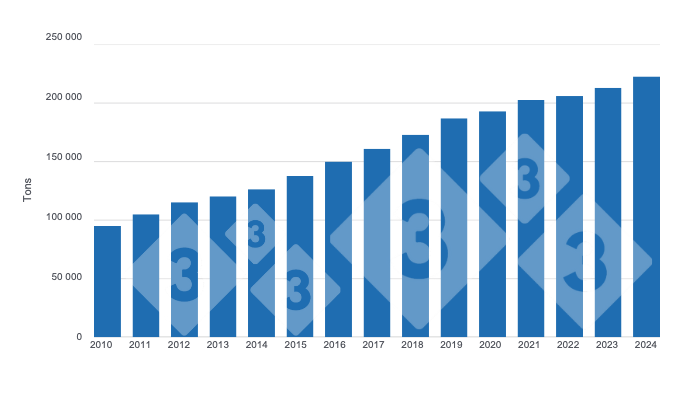
Ecuador's pork sector stands out as one of the fundamental pillars of the country’s agricultural industry, currently accounting for an estimated 8% of the sector’s GDP, generating approximately USD 600 million in annual sales and about 180,000 direct jobs.

This growth is due to significant progress over the past 15 years, with production rising from 95,000 tons in 2010 to over 222,000 tons in 2024, a 134% increase, with an average annual growth rate of 6.3%. In 2024, pork production in Ecuador grew by around 5%, compared to 213,000 tons in 2023, with about 2.76 million pigs slaughtered.
The current national pig inventory is estimated at 2.8 million head, including 129,000 breeding females. Of these, 79,000 are backyard sows, and 50,000 are from intensive systems, representing a 39% intensification rate. There are 166,000 pig producers in Ecuador, 94% of whom are small-scale producers. The country’s five largest pork companies account for nearly 40% of the nation’s commercial breeding sows, with Pronaca leading with 12,000 sows.
According to Agriness data, Ecuador boasts strong production indicators: an 84.14% farrowing rate, 14.06 total piglets born per litter, 2.34 litters/sow/year, and 27.94 weaned piglets per sow annually, putting it on par with regional competitors like Colombia, Argentina, and Paraguay.
Ecuador is notable for its self-sufficiency in meeting domestic pork demand. Over the past decade, imports have decreased by nearly 70%, and 97% of the 230,000 tons of apparent consumption in 2024 came from local production, with only 3% from imports. Alongside production growth, per capita pork consumption has risen, reaching 12 kg/person/year in 2024.
According to the Association of Balanced Feed Producers of Ecuador (Aprobal), 1,186,654 tons of pig feed were produced in 2024, a 3.3% increase compared to 2023 (1,148,897 tons). Approximately 600,000 tons of domestic corn were used for feed production, as the central government prioritizes local grain production and strictly controls imports. Pronaca is the leading feed producer, accounting for about 30% of national production (366,000 tons), followed by other key companies like Molinos Champion, Alimentsa S.A., Balanceados Nova S.A. (Balnova), Avipaz Cia. Ltda., and Bioalimentar Cia. Ltda.
The outlook for Ecuador’s pork industry is promising. By 2030, pork production is expected to reach 280,000 tons, representing 25% growth compared to 2024, along with a significant increase in domestic consumption. The sector has also taken its first steps in export markets, with pork entering the Ivory Coast in 2023 and Vietnam in 2024, paving the way for further expansion into international markets.
Editorial Department of Economy and Sustainability of 333 Latin America | Sources: Asociación de Porcicultores del Ecuador (ASPE) | https://aspe.org.ec/ | AGRINESS | https://agriness.com/es/porcinos | Asociación de Productores de Alimentos Balanceados de Ecuador (APROBAL) | https://aprobal.com/





